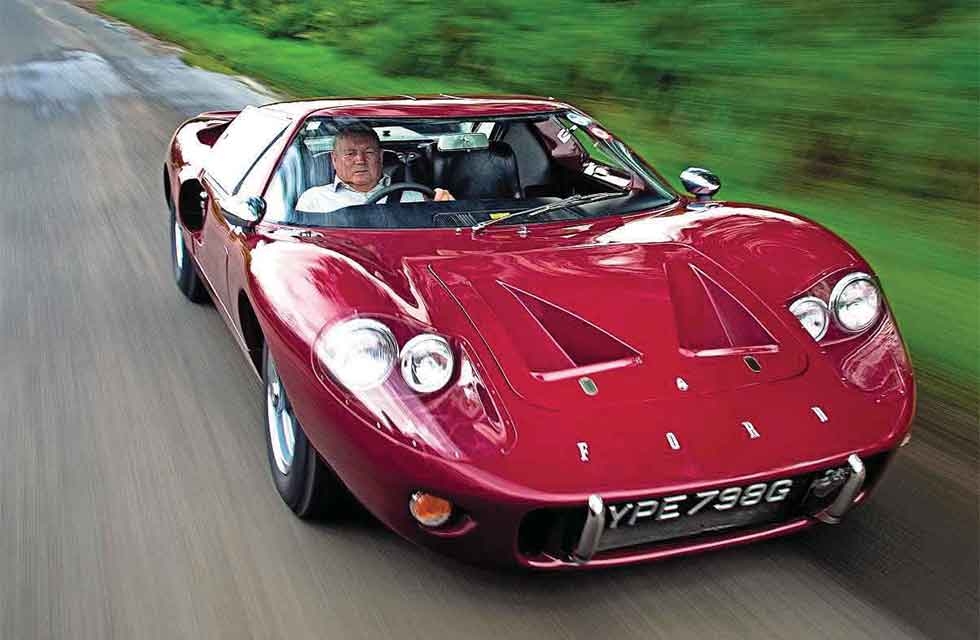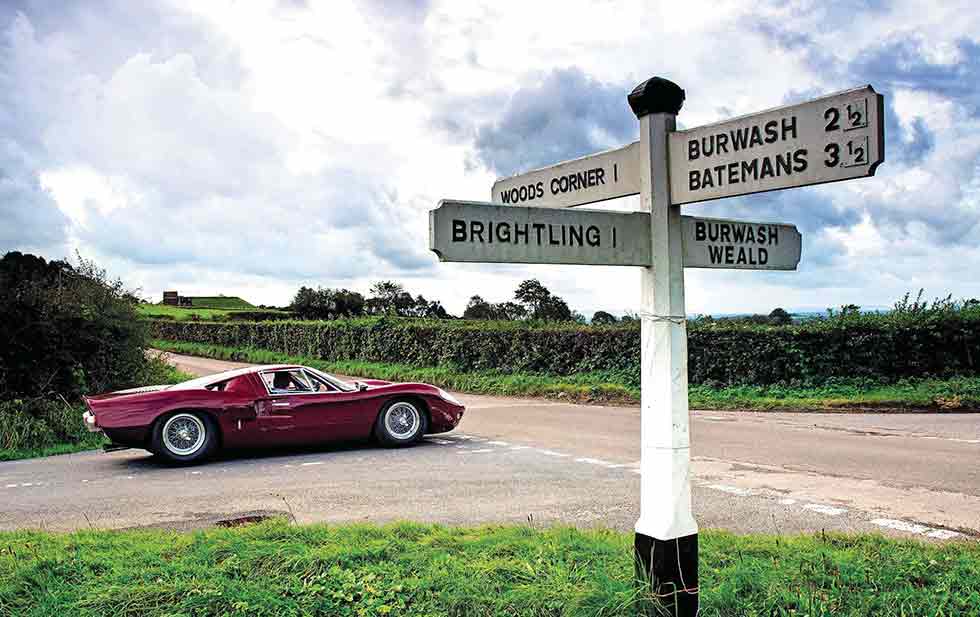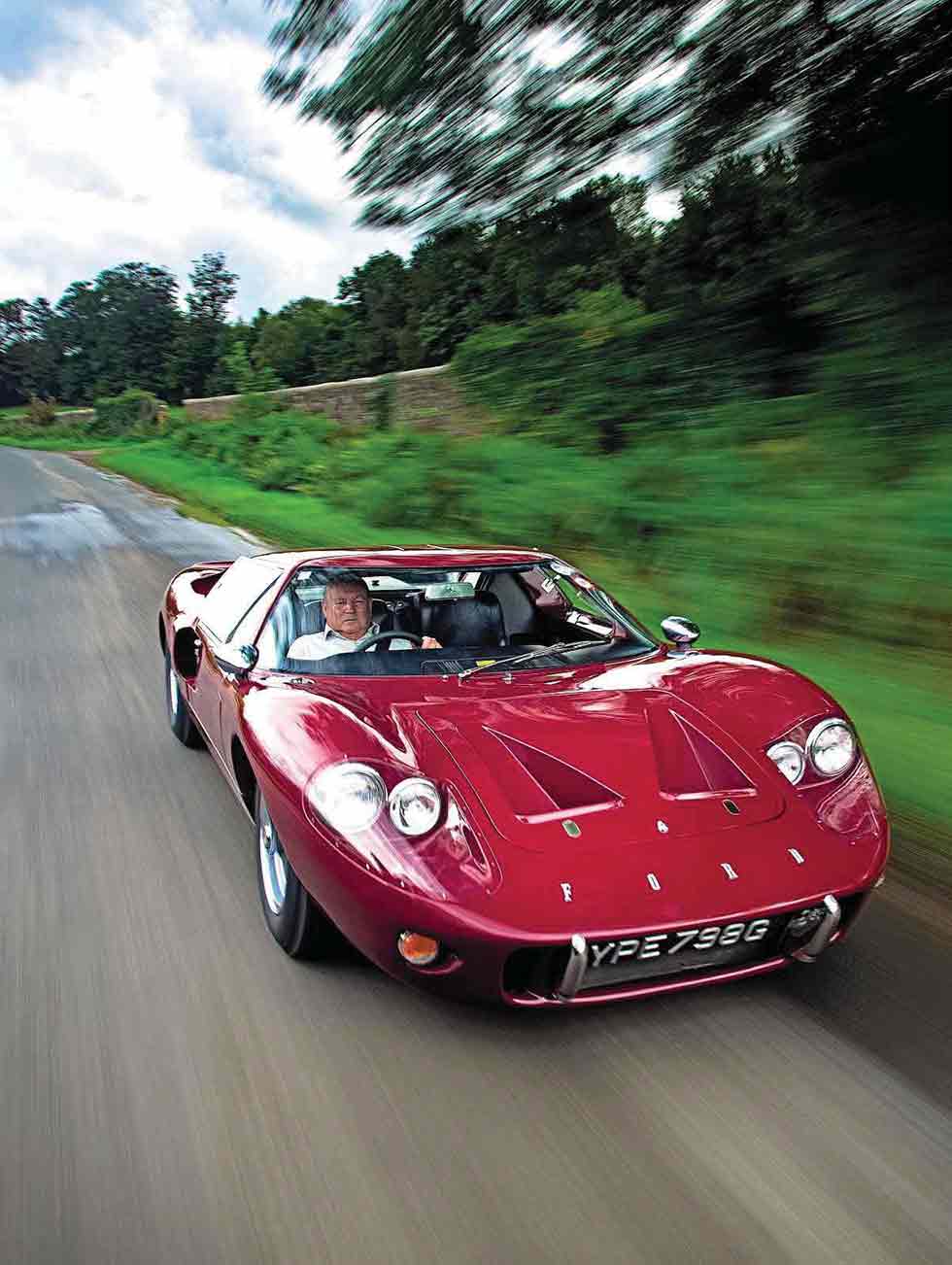
Road from glory. In the 1960s, Ford won Le Mans four times with the GT40. It also built seven roadgoing versions. Madness? Robert Coucher clambers in and finds out. Photography Paul Harmer.
GT40 VHAT IT’S REALLY LIKE ON THE ROAD
Ford GT40 on the road Designed to win Le Mans; seven built as road cars. Madness?
The Bucolic English countryside might seem an incongruous location for the Ford GT40. Versions of this great sports racer dominated Le Mans from 1966 to 1969, with four outright victories. Texan Carroll Shelby, who himself had won Le Mans in 1959 in an Aston Martin DBR1 with Roy Salvadori, was behind the GT40’s first win at La Sarthe, and now GT40s are so prized that one sold in August for $11 million.
‘That pedigree and a hefty price tag meant the GT40 was only going to appeal to “ell-heeled enthusiasts’


‘Roadgoing? Hmm, a loose term. This makes the Ferrari F40 seem like a sensible hatchback’
Actually, a quiet cup of tea is appropriate because this seemingly all-American sports racer is in essence a very British car that began its life in the unedifying suburb of Bromley, Kent, after the Big Swinging CEO of Ford, Henry Ford II, was figuratively slapped in the face by arch autocrat Enzo Ferrari. After Ford spent a lot of time and money looking into buying Ferrari, Enzo backed out at the very last moment. War was declared. Hank the Deuce, as Henry was sometimes known, set about funding a team to crush Ferrari at Le Mans. ‘Fred (actually Eric) in a shed’ meets ‘Hank the Yank’. And the rest is a great movie script.
Ford looked at Lotus, Lola and Cooper before deciding Eric Broadley’s Lola operation would form the most successful collaboration for a world endurance tie-up, based largely on the success of the advanced Lola Mk6, which was already using a Ford V8. Ex-Aston team manager John Wyer was hired and Ford man Roy Lunn was sent to England, where Ford Advanced Vehicles was set up in Slough, near Heathrow Airport.
The Ford GT, as it was originally known, was constructed in a number of variations, primarily racing cars in GT40 Mkl, Mkll and 1966 MkIV iterations, with just 102 manufactured in total. This 1968 Mklll, chassis number M3/1103, is one of only seven road cars created by Ford, and went on sale with a sticker price of $18,500 – $2000 more than a GT40 in race spec! – so it was not just wild-looking but also wildly expensive. Roadgoing? Hmm, a loose term. This makes the Ferrari F40 seem like a bean counter’s sensible hatchback.
Some of you might recognise 1103 as the recent winner of the Per il Miglior Restauro award at the 2012 Concorso Villa d’Este, or from the lawns of the 2012 Windsor Castle Concours of Elegance. It has also been nominated for Restoration of the Year at the International Historic Motoring Awards. A special car with an interesting back-story.
Current custodian and anglophile Gary Bartlett has appeared in the pages of Drive-My, most recently when we drove his ex-Bob Tullius Group 44 Jaguar XJ-S at the 2012 Goodwood Festival of Speed. Bartlett is well known for his superb Jaguars, including C-types, D-types and two XKSS models. ‘I have long been intrigued by roadgoing versions of racing cars and absolutely loved my XKSSs,’ says Bartlett. ‘So when I discovered this roadgoing version of the GT40 I could not resist a closer look.
‘The car was originally purchased by [former Daily Express owner] Sir Max Aitken, then in 1973 was passed on to Brian Auger, who we initially thought was part of the band Trinity but it seems was actually a potato farmer in Norfolk. He turned it into a Mkl lookalike and it passed to another owner in 1981, who put it in the National Motor Museum at Beaulieu. Apart from the cosmetics, close inspection revealed the GT40 was remarkably original and it had covered just 6000 miles.’
The GT40 Mklll was despatched to CKL Developments in Battle, the renowned Jaguar racing and engineering outfit that Bartlett entrusts all his Jaguars to. The project was taken on by Barry Burgess, whose mission was to carefully strip the Ford and sympathetically return it back to its as-new specification, using as many original components as possible. CKL had previously done a similar task with Bartlett’s XKSS.
The MkI facelift undertaken in 1973 included painting the GT white with blue stripes and fitting Halibrand alloys and racing tyres. The interior and mechanicals were left well alone, apart from the fitment of a racing exhaust. Fortunately all the discarded original parts were found stored in a dry loft. These included the lovely Borrani wire wheels, the luggage box, the bumperettes, original exhaust headers and the rather homespun-looking tailpipes you see fitted here.
Burgess then set about taking the GT40 to pieces, and he was amazed at its condition. ‘It was clearly manufactured as a racing car with slight alterations to make it road legal, the most obvious being the higher front headlights to meet American regulations,’ he says. ‘But, being a thinly veiled racing car, it was shoddily put together. Underseal was all over the place and there was overspray everywhere. Amazing for a car that cost more than any Ferrari or Maserati when new,’ he laughs.
Because it’s an incredibly rare and special racing car, all components on the GT40 are dated. Wheels, brake calipers and suspension castings are all stamped 1966 and 1967, so it was imperative to keep everything together. The dated brake servos were not simply replaced, they were sent back to Apple Hydraulics to be rebuilt. The original dated washer bottle was also rebuilt and the shot radiator expansion tank was reconstructed with the welds made to look as bad as the original’s! The twin Kenlowe cooling fans are original and great care was taken to paint the engine block in the exact Ford blue. The Koni dampers were rebuilt but not painted in fresh orange because the original paint was just fine.
The original funky Amaranth-coloured paintwork was found in situ under various pieces of trim and, once the oversized flared arches had been trimmed back to the correct size, the glassfibre bodywork was resprayed to match. Consumables such as bearings, seals, hoses, brake hydraulics, valve springs, piston rings and so on were replaced, but most of 1103 remains original – the car rightfully received its ‘most sensitive restoration’ award at Villa d’Este.
So here we have a roadgoing version of an Anglo-American racing car that won Le Mans four times on the trot, with a Ferrari-baiting 1-2-3 finish in 1966. With Dan Gurney and AJ Foyt winning in the Shelby- developed 7.0-litre MkIV, a true all-American victory at Le Mans was achieved and has never been repeated.
Such an illustrious racing pedigree and correspondingly hefty price tag meant the GT40 Mklll was only really going to appeal to serious and well-heeled enthusiasts. Of the seven constructed, chassis number 1105 was sold to car-mad Austrian conductor Herbert von Karajan and it now resides in the Petersen Automotive Museum. John Wyer used one as a road car, as did Henry Ford II, and 1107, the 1971 London Motor Show car, was used by Ford of Europe vice president Walter Hayes and is seen regularly at Goodwood on duty as the Course Car.
Chassis 1104 is apparently in Argentina, where its original dark green paintwork has recently been changed to bright red, and 1101 has been converted to Mkl spec, though the owner, having observed what Gary Bartlett has done with this one, is apparently giving consideration to restoring his example back to original.
Bartlett’s car was sold new to Sir Max Aitken: knight of the realm, decorated World War Two fighter pilot, powerboat racer and chairman of Beaverbrook Newspapers, Sir Max was the consummate English gentleman – except he was actually born in Canada. Now, on the public roads in East Sussex not too many miles away from where Gary Bartlett’s family originated before moving to America, this understatedly painted GT40 looks very small and compact. In narrow-body Mklll configuration it is only 70in wide and, of course, just 40in high. Without massively flared haunches it appears lithe and elegant, helped by the tasteful Borranis and their triple-eared spinners picking up the chromed rear¬view mirrors, side window trim, doorhandles and overriders.
Thumb the recessed doorhandle and the large three-dimensional door swings open with half the roof coming with it. The doors are large clamshells, so not ideal in tight spaces, but at least they offer a way of dropping into the tight cockpit. The fat, recumbent seats are mounted close together in the middle of the car, with wide sills on either side. These perforated leather chairs with chrome vent holes and cross- stitching look vaguely nightclub and the whole interior is very black. It is also very small, so goodness knows how driver-and-navigator teams compete in tough rallies like the Tour Auto in these confines.
The best way in is to put your feet on the seat squab and then let your body slide in under the steering wheel with a flop. Getting out is even less gracious! But once you’re in position the seat proves comfortable if very reclined, and the ‘Formula GT Britain’ inscribed steering wheel is vertically mounted in front of you, with its simple Ford GT logo on the central boss. The wooden-topped gearlever is centrally located – to facilitate both left- and right-hand drive options – and the puny Mowog (as fitted to original Minis and Minors) handbrake lever catches your left elbow. The cheap plastic dashboard has the Smiths rev counter mounted right in front of you with the speedometer off to the left. A welcome sight are the cooling fan sliders positioned in the centre of the dash, with eyeball air-vents on either side.
To start the GT40 you simply give the Holley four-choke carb a bit of a prime with the throttle pedal and turn the key. The big 302ci V8 fires with a blat and then settles down to a reasonable idle. It reacts instantly to the throttle, even if it is in a detuned state in the Mklll. The clutch action is moderate but short and you need to be aware that it is a small twin-plate racing job. The dog-leg, five-speed ZF 5DS gearshift is the challenge. Its long linkage aft means the selection is a bit hit-and-miss. This is combined with a semi-sequential selection process whereby you have to go through the gears in order and you cannot miss any out, changing up or down through the ‘box. This was to prevent tired racing drivers wrong-slotting the gearlever and blowing the engine.
Pulling away, first is high but allied to a light overall weight of just 1061kg and more than 3001b ft of torque at low revs the GT40 is off and running with ease. The steering is rather dead and heavy and you have to adjust to viewing the outside world from such a low driving position – the front wings rise up high on either side of the car but you cannot see the end of the nose, nor is there much rear three-quarter vision. As you take the gearshifts slowly, the Ford’s lovely, benign engine helps all the way and, running through the narrow English country lanes, you soon relax. That’s until a Range Rover comes hurtling the other way over a blind brow, looking absolutely enormous!
The GT40 requires considerable concentration, primarily so you can get your head around the obstreperous gearshift and general lack of visibility. But when the road clears, it’s time to toughen up. Drop down into third gear and add a decent squirt of juice – that’s when the car’s racing heritage suddenly scythes through to your senses. The otherwise dead rack-and-pinion steering starts to communicate what the now-warmer Dunlop L-section tyres (5.50×15 at the front and 7.00×15 on the rear) are doing via the very comfortably set-up and sophisticated double-wishbone suspension. Confidence is massively enhanced when you realise you can rely fully on the excellent servo-assisted disc brakes, which stop this light car dead.
The big pushrod V8 engine is gentle and reacts with measured responses. It’s reputedly capable of punching out 306bhp but feels more like a real-world 250bhp, and it spools its power out in a controlled, almost polite manner. The fat wad of torque means you don’t have to change gear that often but the practice makes each gearchange that bit easier. With every mile covered you learn that the GT40 is not actually a brutal animal. The chassis and powertrain are too sophisticated for that and soon you begin to drive the mid-engined car from the seat of your pants like a large kart.
Once you’re used to viewing cars coming the other way from wheel height, you find yourself scurrying the lightweight and reactive little GT40 through the bends at ever-more exciting angles, and it quickly picks up serious speed along the short straights. Mindful that this original and rare example is worth several million dollars, you don’t want to get too carried away. With the air vents open and the fans on full blow, in perfectly suitable mild weather conditions the car remains comfortably ventilated. However, because the radiator’s water pipes run through the central tunnel and bulkhead, the interior is notorious for becoming extremely hot – one MkIII was fitted with air-conditioning in period, so that might be a good option if the car is to be used for anything more than exhilarating breakfast runs.
You can understand why this GT40 MkIII is a precursor to the Ferrari F40 as a supercar for the road. It is not as ferocious as the twin-turbocharged, younger and faster Ferrari but it is much better to drive than its contemporary, the Lamborghini Miura.
And that’s ironic because the GT40 is a racing car thinly disguised as a road-going supercar, while the other two are pure road cars with supercar aspirations.
TECHNICAL DATA FILE SPECIFICATIONS 1968 FORD GT40 MKIII
ENGINE 4948cc (302ci) V8, OHV, solid lifters, Holley 4V 715 CFM carburetor
MAX POWER 306bhp @ 6000rpm / DIN
MAX TORQUE 329lb ft @ 4200rpm / DIN
TRANSMISSION ZF five-speed sequential transaxle
SUSPENSION Front: double wishbones, coil springs, Koni telescopic dampers. Rear: lower wishbones, transverse top links, radiusarms, coil springs, Koni telescopic dampers
BRAKES Discs, twin servos
WEIGHT 1061kg
PERFORMANCE Top speed 160mph. 0-60mph 5.5sec
This spread: The ‘40’ in ‘GT40’? It’s just 40in high – about table-top height, so not much room inside. Only seven were built in roadgoing trim, with a detuned, more tractable version of the racebred V8.






